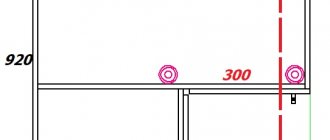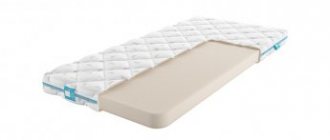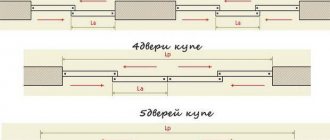Standard kitchen sink sizes
Everyone's preferences are different, so there is a wide range of sizes to choose from. Small bowls are convenient for washing small cutlery, such as tea saucers or cups (you can’t fit a lot of dishes at once).
There are also large products from 80 cm in length. They are convenient for washing large dishes or for defrosting a hefty piece of meat.
The choice depends on food preferences and the presence or absence of a dishwasher.
The standard dimensions of a kitchen sink are 55-60 cm wide and 50-55 cm deep. At the bowl, it varies from 16 to 19 cm. They are convenient when washing forks, spoons, vegetables and cleaning them.
If you prefer to cook dishes that require bulky utensils, then your choice of kitchen sink bowl size will depend on the size of the largest baking sheet or frying pan in your home. A traditional small kitchen sink measures 45 cm wide.
Cabinet and tabletop size
Firstly, the bowl cannot be larger than the cabinet. A smaller size is allowed, but not a larger one.
To choose the right size sink, you need to have 2 measurements:
- Width of the cabinet frame.
- All measurements of the area where you plan to place the sink (if it has a drain). For ease of use, you need to take into account the fact of who you are - right-handed or left-handed? The wing should be located on the corresponding side.
To ensure that when choosing kitchen sinks, they have the appropriate dimensions for the cabinet, you need to follow some general tips:
- Do not allow the sides to press tightly against the wall. You need to leave a gap of 5 cm. Example: the frame of the cabinet is 50 cm wide, which means it is possible to install a sink 45 cm wide (the size of the wing is not taken into account).
- Do not allow the sink to be adjacent to the outer edge of the countertop by more than 5 cm. That is, there is no need to place it close (in size) to the cabinets. Otherwise, while washing dishes, water splashes will fly onto clothes and the floor. But you also don’t need to install it very far away, otherwise it will be inconvenient.
- An overhead kitchen sink (if the choice fell on it) should have dimensions corresponding to the dimensions of the cabinet (example: the cabinet should be 60x60 cm and the sink should be 60x60 cm).
Bowl depth
Some tips for choosing depth:
- The optimal depth of the bowl is 16-19 cm. It is capacious and does not allow water to splash. This is the volume most products have.
- Sinks with a depth of more than 20 cm are good when you constantly use large containers or baking trays. For domestic use, this is not the best idea, since your back will be strained every time. But this can be corrected by raising the cabinet higher.
- Shallow bowls (less than 16 cm) are only good in bathrooms. Because when washing dishes, water splashes will scatter onto clothes, the floor and the countertop.
- If the sink has a diameter of less than 45 cm, then its depth, in most cases, reaches 20 cm or more.
Number of sink bowls
The number of bowls can be completely different. There are sinks with one, two and three sections. Sinks with more than 1 section are especially good and practical: in the first section you can wash dishes, and in the next one you can rinse them. If the kitchen space allows you to place a larger sink (with 2 or 3 sections), then it is better to install just this one, because using these is much more convenient.
To install multi-section sinks, you need a cabinet frame at least 80 cm wide. This is usually required for sinks with 2-3 bowls. Or you can install such a sink on a corner.
If the space is neither large nor small, then one-and-a-half sinks are suitable. Their length starts from 60 cm. That is, there are 2 bowls, just one of them is 2 times smaller than the first.
How to figure out the sizes?
It should be noted right away that various manufacturers of kitchen sinks like to produce sinks exclusively in their own branded sizes. There are several standard sizes for sinks of certain shapes (round, rectangular, etc.), but they are rather the exception in the wide variety of modern models.
The main parameters of sinks can be divided as follows:
- sink size;
- sink bowl size;
- cabinet width;
- cutout for the sink (installation opening).
Sink size
In product catalogs, this parameter is sometimes referred to as “working surface size.” In other words, these are the maximum dimensions of the sink from one edge to the other. Very often, it is precisely these parameters that manufacturers and sellers introduce some confusion by indicating different designations of physical quantities in the same size. Let's understand it with an example. Here is a mortise oval sink made of artificial granite with dimensions 612 x 492. Its photo and drawing.
Please note that the dimensions of kitchen sinks in the drawings are always indicated in millimeters (mm), but in everyday life we most often use the more familiar centimeters.
The manufacturer indicated the following in the technical specifications:
Size (L x W): 612 x 492, i.e. length is 612 mm and width is 492 mm.
The seller posted on the price tag:
Dimensions (W x D): 612 x 492, i.e. the seller has 612 mm - this is already the width, and 492 mm - this is the depth.
Both the seller and the manufacturer are right in their own way, although they created some inconvenience for the consumer.
When choosing the size, keep in mind that when installing it, it is advisable to leave at least 3-5 cm of the countertop from the edges of the sink. This will prevent water from getting on the kitchen “apron”, the floor and on your clothes.
Another important dimension is the thickness of the sink walls. It is of particular importance for stainless steel sinks, the thickness of which varies from 0.4 to 1.4 mm. The thicker the steel, the longer it will last, and the less noise a jet of water will make on it. The optimal thickness is considered to be sizes from 1.2 mm. With a smaller thickness, problems may arise with the stable installation of the mixer.
Sink bowl size
This characteristic is always less than the size of the total working surface. In the case of the oval sink example above, the bowl size is expressed as a diameter of 400 mm. If the bowl were square or rectangular, we would have two dimensions, indicated as length and width, or as width and depth. In the picture below, the bowl size is 350 x 390 mm.
Sinks can consist of 2 or 3 bowls, equal in volume or different from each other. In the second case, the technical characteristics will include such a value as the size of the main bowl, that is, the larger bowl.
The sink bowl has another important parameter – the depth of the bowl. The depth determines how much and what kind of dishes you can put in your sink. With a deep sink, you can safely install a high faucet and not be afraid that the stream of water will splash the surrounding surfaces.
If we return to the drawing of the oval sink, its depth is 205 mm. Find this size at the bottom left of the picture. The standard bowl depth dimensions are 16-20 cm, but there are sinks with a depth of 13-15 cm and 21-25 cm.
Cabinet width
This parameter can also be found under different names. For example, “minimum cabinet width” or “minimum base”. This designates the smallest distance between the side walls of the cabinet into which your model will be built. For the above oval sink, this size is 450 mm. For sinks with several bowls, the cabinet size can be up to 800 mm. To successfully install the round sink in the picture below, the cabinet width must be 600mm.
Cutout for sink (installation opening)
A very convenient characteristic for understanding what size hole needs to be cut in the countertop of the set in order to install a sink there. Each type of sink will have its own special size. In drawings it usually looks like this (see right):
Types of kitchen sinks
Decide where you would like to install the sink: is there room for it on a straight part of the countertop or would it be more convenient for you to use it in a corner? Let's look at the main types.
Direct
The kitchen cabinet under the sink, which has a straight design, has the following dimensions in length: 60-80 cm with two doors; 30-40 cm with one door. Suitable for spacious rooms.
Straight cabinets with sinks are easy to use due to the ease of access to them (unlike some corner models). But oversized cabinets are convenient when there are special drawers. Without them, it is difficult to get the things you need.
Large cabinets are made from oak or beech because they are the most durable.
Corner
The corner kitchen cabinet for the sink has standard dimensions or is made to order. This version of the cabinet is good for placing kitchen appliances, detergents or a water heating system on it.
Standard sizes for corner sinks
Corner planning solutions for the kitchen are rightfully considered the most ergonomic and functional. Largely thanks to the underlying triangle rule.
It is when this is observed that the housewife spends less time and effort walking along the work surface. The corner cabinet under the sink is traditional for Russian kitchens and rarely does anyone decide to abandon it. After all, it is from the corner that all water supply and drainage systems are connected. And transferring them is quite labor-intensive and not always justified.
Types of corner cabinets:
- Straight side corner table. In fact, it is a standard kitchen module with one “muffled” door - a false panel. The most common option in modular kitchens.
- L-shaped corner table-pedestal. The most flexible option in terms of resizing. Most often it is equipped with a transforming door, which significantly expands access to the inside of the cabinet.
- Trapezoidal table-pedestal for sink. The most bulky “classic” version of a corner cabinet under the sink. It is not recommended to install it in small kitchens, as it “eats up” a lot of usable space.
The sizes of the corner sink in the kitchen set are different, because there are sinks with an acute angle and with a beveled one.
The first option is distinguished by the presence of two doors. From the outside, such a cabinet looks like 2 single drawers, but when you open the doors, you get one large drawer with shelves. The dimensions of the corner sink kitchen cabinets are as follows: corner – 87 x 87 cm; side shelf depth – 44 cm; height – 81.5 cm.
Corner sinks with a beveled corner are larger than the previous ones, but in fact more convenient. Their parameters: angle – 85 x 85 cm; shelf depth – 60 cm. To simplify cleaning, legs are included in the package (their length is 10 cm).
Invoice
This type replaces the tabletop. The format matches the cabinets. In addition to the sink, the package also includes separate areas for installing a faucet.
One of the varieties of the overhead system is a sink with an extensive wing. It connects to the main tabletop. This arrangement of the corner is cumbersome in appearance, but every single millimeter of space is used to advantage.
But this type is imperfect, since water will be poured into the joints between the parts of the kitchen unit. Accordingly, the furniture will quickly deteriorate.
Mortise invoice
For installation in the tabletop, you need to make holes in accordance with the dimensions of a certain model. The frame or wing should fit onto the table and rise up. The main thing is to perform high-quality processing of the docking points.
For installation in the tabletop, you need to make holes in accordance with the dimensions of a specific model
Mortise
Built-in kitchen sinks have different dimensions: they are not located above the countertop, but, on the contrary, go deeper inside. This type is expensive, and the installation process is difficult and long, since there are different sizes, and countertops for undermount kitchen sinks are mostly made of artificial stone.
Types of designs: shape and dimensions
The shape of the sink influences its choice, since it must match the style of the kitchen, be comfortable, functional, and spacious. And this is a description of different forms, since the assessment of these parameters is individual for everyone.
Round
The most convenient round kitchen sink measures 45-60 cm in diameter and 16-20 cm in depth. This option is good for small kitchens. Round sinks look neat and laconic.
It is not recommended to purchase a sink that is too shallow or too deep. Because of the first, when used, you and everyone around will be in the water, and because of the second, back pain will be guaranteed.
Oval
Oval sinks are models with a wing. They are presented in formats from 56 to 78 cm (length) and from 44 to 51 cm (width).
The oval shape has many advantages:
- Convenient to wash dishes of any size (both large and small).
- Compactness.
- Dirt will not collect in the corners, since there are none.
- Variety of materials.
- Fits into any interior.
Square and rectangular
These are classics, but due to the use of new materials and manufacturing technologies, square and rectangular sinks fit well into the Art Nouveau style.
Among the parameters, the following are popular: 50 x 60; 60 x 60; 80 x 60; 100 x 60; 120 x 60 cm.
Trapezoidal
Traditional sizes: 90-112 cm (larger side), 40-70 cm (smaller side). The corner part of the kitchen unit for the sink should have dimensions of 90 x 90 cm.
The front of a trapezoidal sink is either concave or straight. You should not make the bedside table small, as the presence of small doors will complicate use.
Other forms
If you don’t like the usual forms, then you can do something unconventional. As a rule, this is done when there is no space at all or the concept of the room requires informal solutions.
The triangular sink is installed directly into the corner part of the set. It takes up minimal space. And if a non-standard shape is included in the kitchen concept, then they can order any shape, for example, a crescent-shaped sink.
Materials
The shapes of sinks and their sizes often depend on the material from which they are made.
Steel
Usually these are rectangular or round bowls. Most often used in the kitchen in our country. They usually have a wing for drying dishes, but they can also be without it. External dimensions for round sinks are 49 or 51 cm, rectangular - 48x85 cm, 50x77 cm, 44x78 cm, 51x58 cm. Depth from 16 cm to 20 cm. Each company that produces kitchen sinks, of course, has its own dimensions, but these numbers will help you navigate when designing your kitchen.
Artificial granite
Sinks made from this material are gaining popularity. Their color palette allows this type of sink to fit into any interior. They are more resistant to scratches and dents than steel sinks and have a long service life. But they also cost much more than stainless steel. They conduct sound poorly, so water pouring into a granite sink is almost inaudible. Their sizes are not much different from metal sinks.
Ceramics
Sinks made from this material do not oxidize or scratch. They will perfectly complement a kitchen in a classic style, but they are very fragile and not shock-resistant. Can be easily damaged and require professional installation.
Cast iron
Cast iron rectangular sinks measuring 50x60 cm were very popular in Soviet times, but now their age has passed. This is because cast iron is susceptible to corrosion and will begin to rust and peel over time. To avoid this, manufacturers coat the bowls with enamel. But over time, the paint chips and wears off. The sink loses its appearance. Although for interiors decorated in the style of the 80s, such a sink would be quite appropriate, and you can still find it in stores.
Recommendations and life hacks for choosing a kitchen sink
- To choose the right size of kitchen sinks, consider the cooking habits of your family - how often you wash dishes, how much you cook, and so on. For example, if the kitchen is small and the family is not large, then choose kitchen sinks with a width of 45 cm;
- Additionally, you can choose a small sink if your kitchen has a dishwasher. However, the depth of the sink should allow large pots and baking trays to be rinsed in it;
- Pay attention not only to the length, width, depth, but also to the thickness of the material and the height of the sides. A mortise sink with higher sides will be more practical, and the thickness of the stainless steel – the thicker the better (acceptable thickness of stainless steel is 1.2 mm or more);
- Much depends on the type of mixer chosen. For example, if you want a faucet built into the countertop, then the size of the sink should be selected taking into account the space for it;
- The standard sizes of cabinets are from 60 to 35 cm. Of course, it is important to first install the cabinet, and then select a sink for it;
- And one more thing - if your set does not have room for a three-section spacious sink, then use a faucet equipped with a pull-out “shower”.
Installation
Installing a sink is not a complicated process; if you make the right choice of product, you can handle it yourself. But there are a couple of categories that are recommended to be left to professionals:
- Built-in sink under the countertop. Rare type, installation is carried out by plumbers. The cost of the products is high. But maximum ease of use is guaranteed.
- Built-in level with countertop. Installation cannot be done without professionals and is very expensive. Difficult to choose based on color and style.
The remaining sinks are installed independently. This is easy to do if the length and width of the kitchen sink are calculated correctly. Then the product matches the cabinet or countertop (depending on the installation location).
A corner kitchen sink is also easy to install, but it is difficult to make cutouts on the set. It is advisable to leave this process to assemblers and/or furniture manufacturers.
Built-in sinks
Stainless steel built-in kitchen sinks are often purchased because... The product is easy to install and has high performance characteristics. For installation you need to: make a cutout in the countertop that matches the size of the sink and wings, if any. Then the sink is installed.
The dimensions of a mortise kitchen sink are minimal. Installation is suitable for kitchens where there is a common countertop. This indicates the small size of the room. Therefore, the sink is not large in size.
The mortise version looks great with the overall interior
The countertop is allowed from any material: granite, laminate, artificial/natural stone, chipboard, steel, granite or wood. Built-in sinks are made only from stainless steel, so they have good parameters and hygiene.
Examples of location and design: photo design and video of sink installation
The size of the sink depends on various factors: shape, type, number of bowls, etc. When choosing, you need to pay attention to all aspects. The main thing is to choose one that is convenient for use. There are no objective assessments here, since comfort is understood differently for everyone.
Other important criteria
When choosing a kitchen sink, you should also consider the following points.
Sink capacity
To choose the right option, you should take into account the number of people in the family, the time that will be spent on cooking, and the kitchen space itself. The volume of utensils involved depends on these factors.
Important! The sink and the size of the kitchen area should be in harmony with each other. The sink should fit not only plates, but also pots.
Room area
The area of the room determines the size of the kitchen sink. So, in a small room, a small or medium-sized sink is appropriate, and spacious kitchens allow you to choose different options. The number of bowls is from 2 to 5, while one-and-a-half models, where one bowl is larger than the other, are in great demand. They are installed in kitchens with a small square footage, where it is not possible to use a large sink with several recesses.
Kitchen style
The overall style of the kitchen should match the sink model. For a classic set, models made of ceramics or artificial stone are suitable. Modern style goes perfectly with stainless steel and artificial stone. In an antique-style kitchen, metal sinks made of bronze or brass look great.
Manufacturer reputation
The choice of which sink is best for the kitchen remains with the customer. However, it is worth paying attention to global manufacturers who offer modern solutions that make working in the kitchen a pleasure.
Kitchen sinks from European manufacturers, primarily from Germany, Italy, Spain and the Netherlands, have the best reputation. The most famous of them: FRANKE, TEKA, BLANCO, SCHOCK, NAYES, ALVEUS, REGINOX.
Easy to use and care
Which sink is best to choose for the kitchen also depends on the frequency of its use and the time spent on maintenance.
Modern housewives increasingly prefer various types of kitchen sinks made of stone, while metal options are losing their popularity. The artificial stone sink has a pleasant appearance, is easy to clean and pleasant to the touch. Also, during operation there is no unpleasant noise or rumble.











